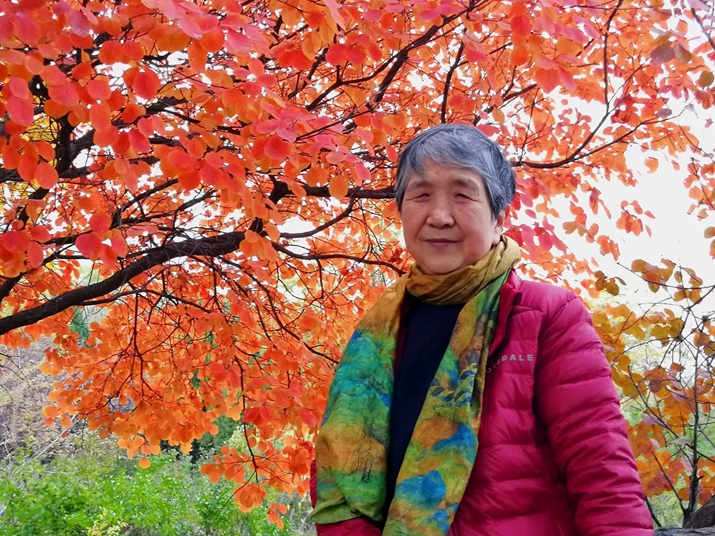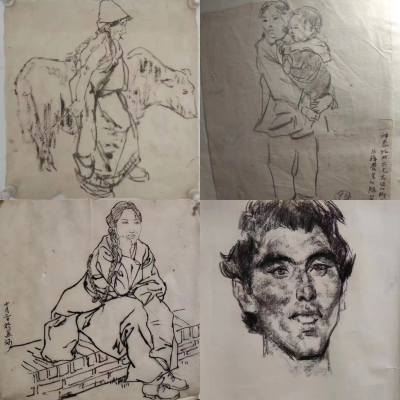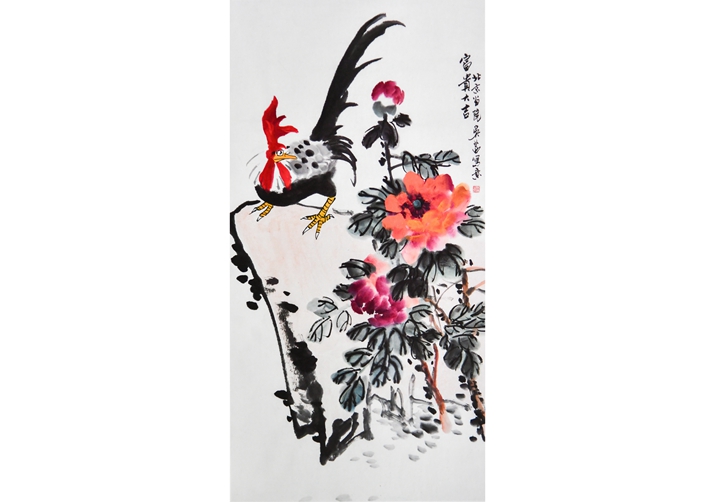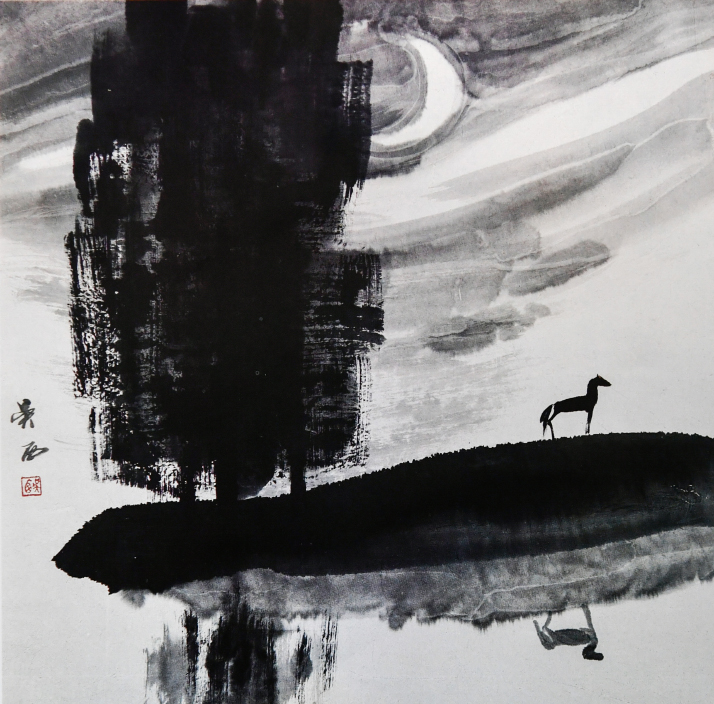| Lifestyle |
| Capturing the creations and inspirations of a Chinese painter | |
| The colorful career of one female Chinese painter | |
|
|
 A photo of Wu Xi, a Chinese painter (COURTESY PHOTO)
It was a day like so many others in Maqu County of Gannan Tibetan Autonomous Prefecture in Gansu Province in 1979. A Tibetan woman was guiding her cow through the alpine wetland landscape when Wu Xi, in active search of inspiration, spotted the pair and penciled a quick sketch. Decades on, 79-year-old Wu's eyes still light up with excitement when talking about this particular painting. "Look how I captured the expression on her facial profile—and I did so in just a few minutes," Wu, a professional painter at Beijing Fine Art Academy, told Beijing Review. Born into a notable and art-loving family in Suzhou, Jiangsu Province, in 1943, Wu was imperceptibly influenced by her surroundings. One of her forefathers, Wu Dacheng (1835-1902), was a renowned calligrapher and painter. Her father, Wu Hewang, had studied painting under Wu Hufan (1894–1968), a leading Chinese painter known as a collector and art connoisseur as well as for his landscape works. Zha Fuxi (1895-1976), an acclaimed master of the guqin, a plucked seven-string Chinese musical instrument, was a regular visitor to the Wu family home. When Wu Xi was 8, the Wu and Zha households jointly moved to Beijing, where the young girl took her first tentative steps into the world of painting. At the very beginning, Wu was learning how to draw and paint by herself. "I've liked painting since childhood," she said. Her father noticed her gift for the arts and got her a host of related books through which Wu began building and stretching her own professional canvas, including both Chinese and Western styles such as the works of Ilya Yefimovich Repin, a remarkable figure of Russian Realism during the 19th century. "The artistic and literary inspirations aside, there was this Soviet Union documentary novel called The Early Sunrise, which told the story of a young painter who died at the age of 15," Wu said, adding the book inspired many children immersed in the fine arts at the time. She later enrolled at the Beijing Industrial Art School, known today as the College of Art and Design at the Beijing University of Technology, to study sculpture and painting. After graduation, Wu worked at an institute designing product packaging for several years and following her stint there, finally entered the Beijing Fine Art Academy in 1978 with a recommendation letter from Zhou Sicong (1939-96), a famous Chinese female painter.  A collection of Wu Xi's quick sketches over the decades (TAO XING)
A creative explorer "When studying at the Beijing Industrial Art School, we got quick sketch homework every week," Wu said, adding this would always get her creative juices (over)flowing. If the teacher told them to do 10 drawings, she would hand in 20. And her proclivity for quick sketching persists to this day. "Compared to, for example, an object sketch, it better trains you as you need to wholly capture the subject and finish it in minutes," she said. When designing packaging at the institute, Wu would hone her painting skills during the weekend. She would even show up on the doorsteps of Li Kuchan (1899-1983), a famous painter known for combining Western techniques with traditional Chinese styles, and Ye Qianyu (1907-95), an influential painter and cartoonist best known for his manhua (caricatures), to show them her works and get some constructive feedback. The masters were both moved by her imaginative spirit and talent and agreed to guide her through her artistic exploration. "Wu is an outstanding painter," Li once said. Her unswerving pursuit of the fine arts over the years ensured Wu built a solid foundation in painting. More specifically, her training in Western styles allowed her to enhance her traditional Chinese creations. For example, mastering the art of the quick sketch helped her seize the most fleeting moments of daily life or a person, in turn enriching her endeavors in the realm of Chinese painting—which traditionally focuses on the opposite, namely, classic, fixed subjects or static gestures. Also of note here has been Wu's enduring and adamant opposition to the inflexible pursuit of the classical and the blind copying of foreign artists. "In Chinese ink painting, for example, I will use more color, a kind of 'breakthrough' compared with its traditional black and white palette," Wu said. But blindly injecting the old with something new is not the way to revolutionize art. "First, I need to improve my basic skills, for example, the sculpting ability, day by day, year by year," she added.  A vibrantly colored Chinese ink painting by Wu (WEI YAO)
A cultural carrier Wu's works have been exhibited both at home and abroad, meeting with widespread acclaim. One of her most representative work to date, The Dim Light of the Night, was displayed at the 1989 Monte Carlo International Exhibition of Modern Art in Monaco. It was branded one of the exhibit's 200 masterpieces, chosen from over 8,000 paintings by 2,000 artists from 68 countries.  The Dim Light of the Night, one of Wu's most revered works to date (WEI YAO)
"In Night, a crescent moon hangs in the boundless night sky in which floats a few thin clouds; inverted reflections are seen in the limpid, quiet river water, and a tall tree stands tall on the bank. What a moving picture this is!" Zhao Mingzhen, a Chinese art critic, described the creation. Then Indian President Ramaswamy Venkataraman, during a visit to Beijing, met with Wu and her artist husband He Yang at the Diaoyutai State Guesthouse on May 18, 1992, and gladly accepted the paintings they presented to him. Late German collector Peter Ludwig bought eight of Wu's paintings in 1996. That same year, Ludwig and his wife Irene also donated 89 artworks from their collection to the National Art Museum of China, as a demonstration of the Sino-German friendship. In 1995, Wu and He founded the first private modern painting museum in China—the Heyang Wuxi Modern Painting Museum in Beijing. Today, the museum not only displays the couple's works, but also organizes different types of international art communication and public training events to promote Chinese paintings. Even on the verge of becoming an octogenarian, Wu's passion for painting remains strong as ever. "Painting is not a part of my life; it is my life," she concluded. Theirs truly is an affair to remember. (Print Edition Title: An Affair to Remember) Copyedited by Elsbeth van Paridon Comments to taoxing@cicgamericas.com |
|
||||||||||||||||||||||||||||||
|
